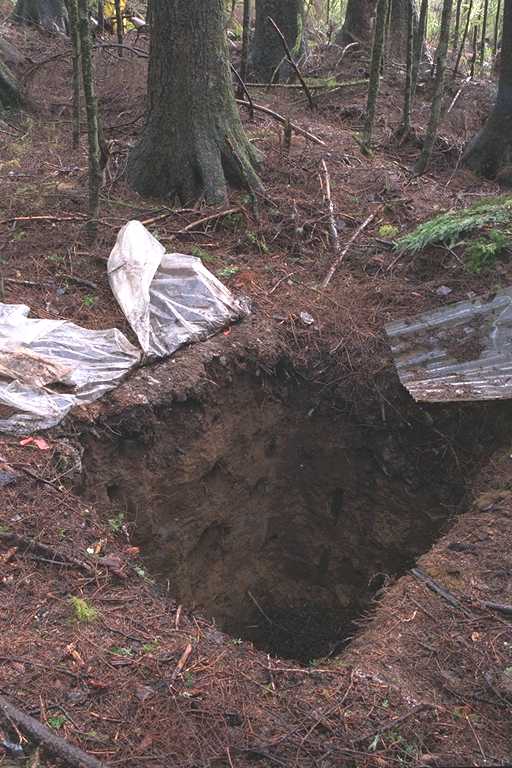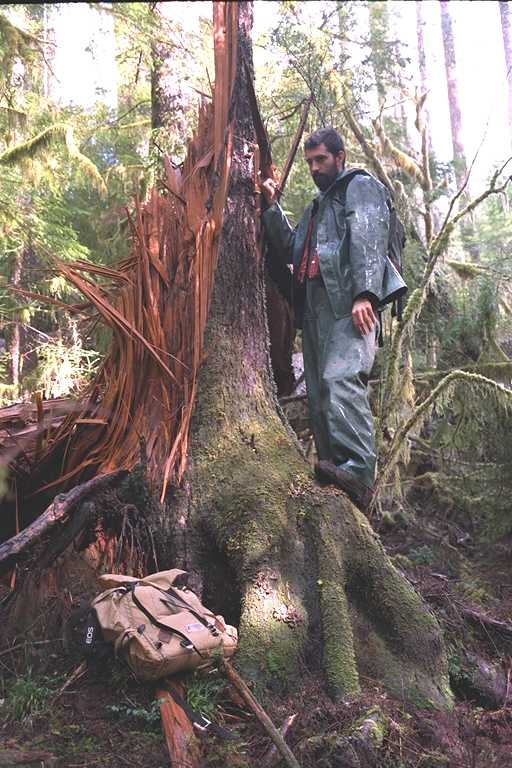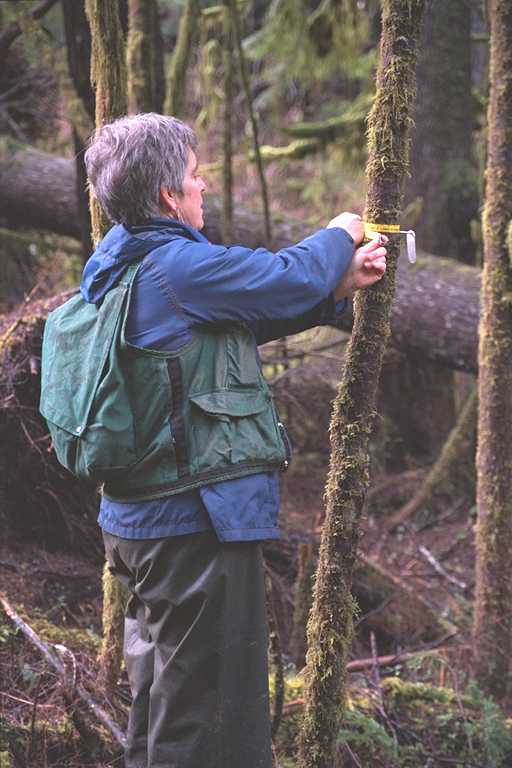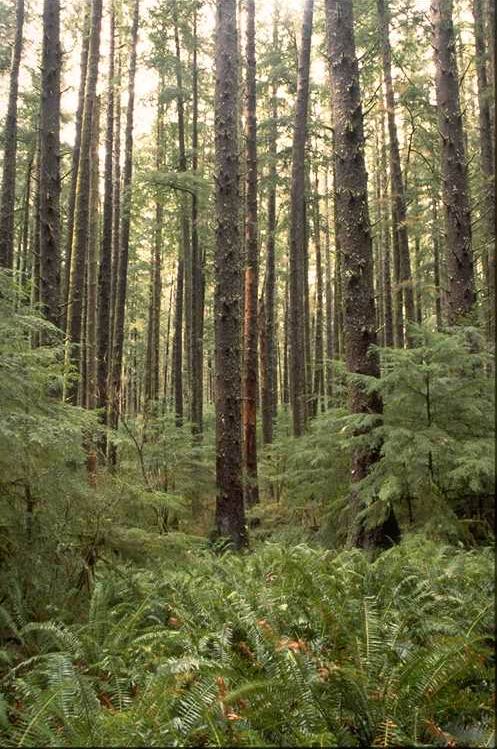Permanent Plots of the Pacific Northwest, USA
Report Number 3
Growth and Yield Permanent Plots at the
Cascade Head Experimental Forest
Prepared by: Sarah Greene and Steve Acker
May 1999
Citation
Link to Cascade Head Experimental Forest website (http://www.fsl.orst.edu/chef).
CONTENTS
Citation: Greene, Sarah E.; Acker, Steven A. 1999. Growth and yield permanent plots at the Cascade Head Experimental Forest. Permanent Plots of the Pacific Northwest. Report Number 3. (http://andrewsforest.oregonstate.edu/pubs/webdocs/reports/permplot.cfm)
Introduction
This report describes key characteristics of permanent vegetation plots that were established in 1935 at the Cascade Head Experimental Forest. The original objective of these plots was to follow diameter and height growth of trees and yield in a coastal Oregon Sitka spruce-western hemlock (Picea sitchensis-Tsuga heterophylla) forest. The plots have been measured on a regular basis (generally very five years) since establishment. Since the 1970s more detailed information on the process of tree mortality has been recorded. Tree recruitment has been monitored since 1983.
Location
The permanent plots lie within the Cascade Head Experimental Forest in the north- central Coast Range of Oregon. The 3947-ha experimental forest lies at approximately 45 deg 02 min north latitude and 123 deg 58 min west longitude. The west boundary of the forest is the Pacific Ocean. Though much of the topography throughout the experimental forest is steep and highly dissected, the plots are generally on more level terrain. Elevation of the experimental forest ranges from sea level to 425 m.
Study Area

The three dominant plant communities (Hemstrom and Logan 1986) in the forest are Sitka spruce-western hemlock /swordfern (Polystichum munitum), Sitka spruce-western hemlock/devil's club (Oplopanax horridum) and Sitka spruce-western hemlock/salmonberry (Rubus spectabilis). The Nestucca Fire, a 205,000-ha fire that burned in the mid-1840s, burned over most of the forest (Morris 1934). Very large Sitka spruce, survivors of the Nestucca Fire, are scattered along streams and ridges. The tall, stately stands of Sitka spruce and western hemlock now covering most of the experimental forest grew up after the fire. These stands contain some of the greatest wood volume per hectare and highest growth rates of any temperate forests in the world.
Sitka spruce and western hemlock dominate the forest along the coastal edge. As one moves inland spruce begins to drop out and is eventually replaced by Douglas-fir (Pseudotsuga menzeisii). Western hemlock remains a dominant species throughout the forest. Red alder (Alnus sinuata) is common throughout the forest especially along streams and in recently disturbed uplands. Western redcedar (Thuja plicata) is more common away from the coastal influence, but is not prolific. Dominant understory shrubs include salmonberry, red blueberry (Vaccinium parvifolium), fool's huckleberry (Menziesia ferruginea), devil's club, and thimbleberry (Rubus parviflorus); dominant herbs include swordfern, oxalis (Oxalis oregana) and a high diversity of mosses.
The area has a strongly maritime climate. It is wet and cool; seasonal and diurnal fluctuations in temperature are minimal. Strong ocean winds from the southwest sweep the area, particularly in the winter. Although most precipitation occurs during the winter, there is no drought in the summer. Summer fog is a dominant climatic phenomenon in the western half of the experimental forest. Summer fog can increase precipitation as much as 26% in the summer. Annual precipitation is 2496 mm. Average temperatures are 10.4 C.
Soils are derived primarily from tuffaceous siltstones, with basalt intrusions occurring closer to the coast. Soils are moderately fine textured, moderately well drained, and very deep (up to 100+ cm).
History of the Cascade Head Growth and Yield Plots
Twelve 1-acre, square plots were established throughout the experimental forest in the spring of 1935. Original cedar corner posts have been replaced with PVC over rebar, and each plot has GPS coordinates on one corner. The existing stands were generally even-aged with an average age of 83 years and ranged from nearly pure Sitka spruce to pure western hemlock. Of the twelve original plots only nine remain today; one each was lost to road building, logging, and the 1962 Columbus Day windstorm. Plots were remeasured in 1940, 1945, 1955, 1968, 1978 and every five years thereafter. The last measurement for plot 9, which was logged, was 1945; the last measurement for plot 6, which was blown down, was 1955. One plot (12) was the site of an intensive study conducted by Charles Grier on ecosystem production (Grier 1977). Areas adjacent to 5 plots (4,5,7,10 and 12) are being used to study root decomposition (Chen 1999).
The 1935 establishment report for the plots describes understory vegetation for all 12 plots. The herb layer in most plots was dense, dominated by a variety of herbs including oxalis, springbeauty (Montia sibirica), coolwort (Tiarella unifoliata), trillium (Trillium ovatum), beadlilly (Clintonia uniflora) and fairy-bell (Disporum smithii). Moss was common in all plots, as was swordfern; bracken fern (Pteridium aquilinum) was pervasive in plot 11. The shrub layer varied amongst plots, mostly made up of red blueberry and fool's huckleberry. Data on understory vegetation was again measured in 1995, but the data have not been analyzed.
Methods

When each plot was established boundaries were surveyed, boundary trees blazed and corner posts set and numbered. Aluminum tags were nailed at breast height (usually 4.5 feet) to all trees greater than or equal to1.6" dbh (diameter at breast height). Diameters at breast height were measured to the nearest 0.1". Heights of 10-40 trees per acre were measured to the nearest foot. Age counts were made on increment cores from 10-25 trees per plot. Initially, volume-diameter-height relationships were developed from tarif access equations for trees with height measurements (Smith et al. 1984). Site index determinations have been made for all nine plots.
Starting with the 1978 remeasurement, measurements were converted from English to metric units. Trees growing into the minimum diameter class (now 5 cm) began to be tagged, though numerous trees were tagged that were greater than 10cm dbh. Though tree mortality was noted on the data sheets up to this time, 1978 marks the beginning of gathering more in depth mortality data including location of dead tree parts (standing or on the ground), symptoms related to mortality, and causes of mortality.
As of 1990, new equations have been developed for individual tree volume that are specific to the three major tree species and different intervals of the history of the plots (Harcombe et al. 1990). Biomass of living and dead trees is now calculated by multiplying species-specific wood density by individual tree volume.
Downed coarse woody detritus (>10 cm diameter at large end) was measured in all plots in 1992 using the line intercept method (Harmon and Sexton 1996). The diameter, species and decay class of all downed wood in the plots were measured. Standing dead trees >10 cm DBH and > 1m tall were inventoried on the entire plot by measuring the basal and top diameters and height.
Two soil pits at least 1 m in depth were dug in each plot (see Remillard et al. 1997). Soil texture, rockiness, bulk density, as well as carbon and nitrogen content were determined. The latter three variables were determined for three depths: 1) 0-20cm, 2) 20-50 cm and 3) 50-100cm. The mass of the organic layer was determined by 5 cores taken above the sampling face of the soil pit. These samples were composited for each soil pit.
General Stand Description

The forest sampled represents a highly productive, mature coastal forest. Windthrow is a common form of disturbance and has accounted for at least 40 % of the tree mortality over the last 60 years.
Click here for most recent summaries for each plot.
Note that plots 06 and 09 are summarized for 1955 and 1945 respectively.
Related Publications
Acker, S. A.; Harcombe, P. A.; Harmon, M. E.; and Greene, S. E. submitted 1999. Biomass accumulation over the first 150 years in coastal Oregon spruce-hemlock forest. Journal Vegetation Science.
Greene, S. E.; Harcombe, P. A.; Harmon, M. E.; Spycher, G. 1992. Patterns of growth mortality and biomass change in a coastal Picea sitchensis - Tsuga heterophylla forest.
Journal of Vegetation Science. 3: 697-706.
(HJA pub# : 1212)
Remillard, Suzanne Marie. 1999. Soil carbon and nitrogen in old-growth forests in western Oregon and Washington. Corvallis, OR: Oregon State University. 121 p. M.S. thesis.
Data Access
Raw data describing the
vegetation,
woody detritus, and
soils
of these permanent plots are available on the web.
Acknowledgements
Funding for the maintenance of these plots is from the Pacific Northwest Research Station of the U. S. Forest Service, Corvallis, Oregon and from NSF-Long Term Studies (DEB-9632921).
References
Chen, H. 1999. Root decomposition in three coniferous forests: effects of substrate quality, temperature, and moisture. Ph.D. Dissertation, Oregon State University. 214p.
Grier, Charles C.; Running, Steven W. 1977. Leaf area of mature northwestern coniferous forests: relation to site water balance.
Ecology. 58: 893-899.
(HJA pub# : 1848)
Harcombe, P. A.; Harmon, M. E.; Greene, S. G. 1990. Changes in biomass and production over 53 years in a coastal Picea sitchensis - Tsuga heterophylla forest approaching maturity.
Canadian Journal of Forest Research. 20(10): 1602-1610.
(HJA pub# : 899)
Harmon, Mark E.; Sexton, Jay. 1996. Guidelines for measurements of woody detritus in forest ecosystems.
Publication No. 20. Seattle, WA: LTER Network Office, University of Washington. 73 p.
(HJA pub# : 2255)
Morris, William G. 1934. Forest fires in western Oregon and Washington. The Oregon Historical Quarterly. 35(4):313-339.
Remillard, S. M.; P. S. Homann; B. T. Bormann, and M. E. Harmon. 1997. Distribution of soil organic Carbon and its relation to climate and site characteristics in western Oregon and Washington. Soil Science Society of America Annual Meeting, Anaheim, CA.
Smith, Stephen H.; Bell, John F.; Herman, Francis R.; See, Thomas. 1984. Growth and yield of Sitka spruce and western hemlock at Cascade Head Experimental Forest, Oregon. Research Paper PNW-325. Portland, OR: U.S. Department of Agriculture, Forest Service, Pacific Northwest Research Station. 30p. (HJA pub#: 156)





